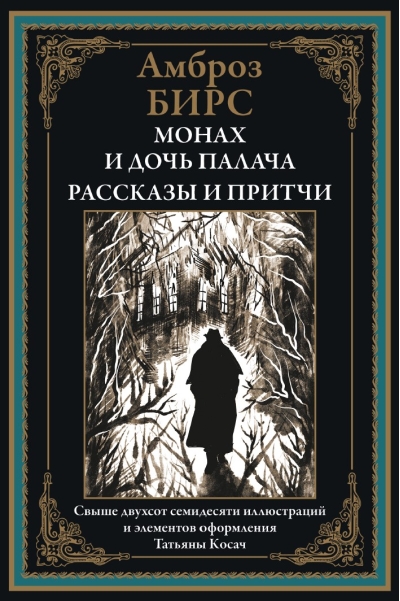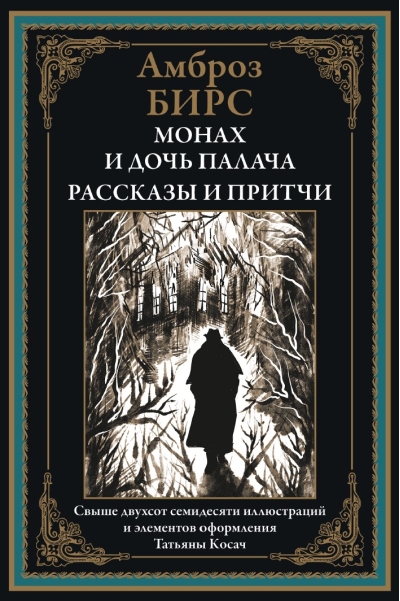The Monk and the Executioner's Daughter: Stories and Parables
14.99 €
Out of stock
The collection includes various works by Ambrose Bierce (1842-1914), who in the United States deservedly earned his fame as a master of "gothic prose". In his texts, dark and mystical, Bierce tried to bring the description of the terrible to the possible limit. His story "The Monk and the Executioner's Daughter," translated by I. Bernstein, is a free retelling of the novel "The Monk of Berchtesgaden" by the German writer R. Voss. In addition to the story, this edition includes more than seven dozen short parables by Beers, as well as twenty-three stories by the writer. The edition is accompanied by drawings and lettering by artist Tatiana Kosach.
Ambrose Bierce was counted among the classics of American literature in the middle of the twentieth century; by that time the writer was long gone. He probably would have been surprised to learn that his fame brought him gloomy and imbued with a cynical view of life stories and novels in the style of "gothic prose". About a dozen of them have entered the golden fund of American classics. Ambrose wrote them rather for a narrow circle of admirers than for the general public, which Beers was known primarily as a talented journalist, hard scourged in the late XIX century vices of American society. The remnants of youthful romanticism Ambrose lost during the Civil War, which he came from a poor, large farming family, went to volunteer. Bierce went through all the major battles, became convinced of the senselessness of sacrifice and settled in San Francisco. To return to the former casual earnings did not allow pride - Beers retired as an officer. Find his own, independent way in life helped talent writer. The father of the future writer had a good library - thanks to her Ambrose got acquainted with the literary classics. Later he contributed to it, becoming the author of laconic innovative prose, which had a huge impact on the development of American "dark literature". Bierce's follower on this path was the American writer Howard Phillips Lovecraft, whose works are also full of horror, mysticism and fatalism. Bierce's story "The Monk and the Executioner's Daughter", with which this collection begins, is imbued with them. It is considered one of the pinnacles of "gothic literature". At the end of his life, the writer, who possessed an unsettled and independent character, in a sense became one of his heroes-fatalists. Bierce did not want to meet with infirm old age. Having reached the age of seventy years, he crossed the border with the revolutionary flames of Mexico. In its flames, he perished without a trace. Probably not for nothing, one of his stories Beers called "Missing in Action". The book is illustrated with drawings by contemporary St. Petersburg artist Tatiana Kosach. She graduated from the History Department of St. Petersburg State University and is a specialist in the art of the Middle Ages. Her iconographic and graphic works can be found in private collections of art lovers in Russia, USA, Italy and France. In the series "Library of World Literature" her illustrations decorate the novels "American Tragedy", "The Financier", "The Financier", "The Tyrant" and "The American Tragedy". , "The Financier", "Titan", "Stoic" by Theodore Dreiser, "Doctor Zhivago" by Boris Pasternak and "The White Guard" by Mikhail Bulgakov.
Ambrose Bierce was counted among the classics of American literature in the middle of the twentieth century; by that time the writer was long gone. He probably would have been surprised to learn that his fame brought him gloomy and imbued with a cynical view of life stories and novels in the style of "gothic prose". About a dozen of them have entered the golden fund of American classics. Ambrose wrote them rather for a narrow circle of admirers than for the general public, which Beers was known primarily as a talented journalist, hard scourged in the late XIX century vices of American society. The remnants of youthful romanticism Ambrose lost during the Civil War, which he came from a poor, large farming family, went to volunteer. Bierce went through all the major battles, became convinced of the senselessness of sacrifice and settled in San Francisco. To return to the former casual earnings did not allow pride - Beers retired as an officer. Find his own, independent way in life helped talent writer. The father of the future writer had a good library - thanks to her Ambrose got acquainted with the literary classics. Later he contributed to it, becoming the author of laconic innovative prose, which had a huge impact on the development of American "dark literature". Bierce's follower on this path was the American writer Howard Phillips Lovecraft, whose works are also full of horror, mysticism and fatalism. Bierce's story "The Monk and the Executioner's Daughter", with which this collection begins, is imbued with them. It is considered one of the pinnacles of "gothic literature". At the end of his life, the writer, who possessed an unsettled and independent character, in a sense became one of his heroes-fatalists. Bierce did not want to meet with infirm old age. Having reached the age of seventy years, he crossed the border with the revolutionary flames of Mexico. In its flames, he perished without a trace. Probably not for nothing, one of his stories Beers called "Missing in Action". The book is illustrated with drawings by contemporary St. Petersburg artist Tatiana Kosach. She graduated from the History Department of St. Petersburg State University and is a specialist in the art of the Middle Ages. Her iconographic and graphic works can be found in private collections of art lovers in Russia, USA, Italy and France. In the series "Library of World Literature" her illustrations decorate the novels "American Tragedy", "The Financier", "The Financier", "The Tyrant" and "The American Tragedy". , "The Financier", "Titan", "Stoic" by Theodore Dreiser, "Doctor Zhivago" by Boris Pasternak and "The White Guard" by Mikhail Bulgakov.
See also:
- All books by the publisher
- All books by the author
- All books in the series Library of World Literature













































